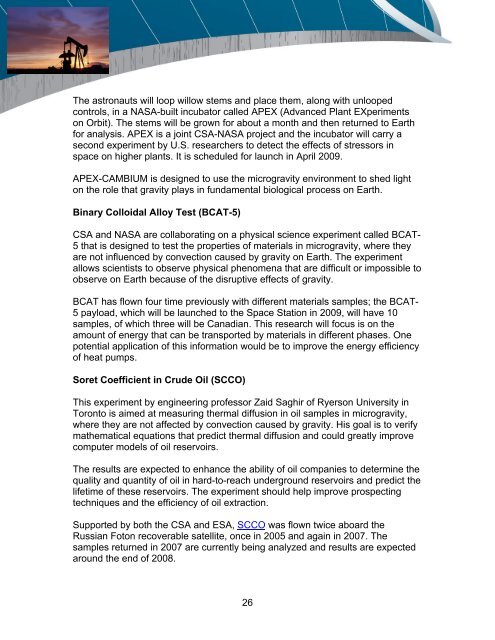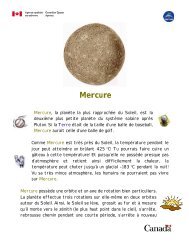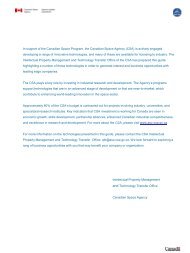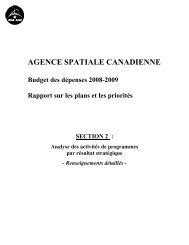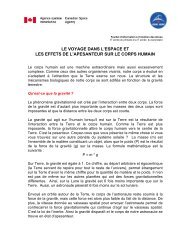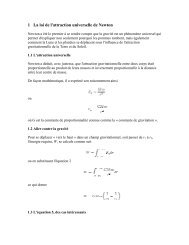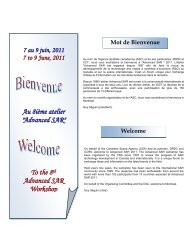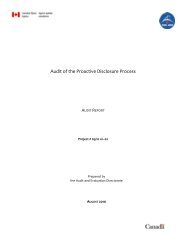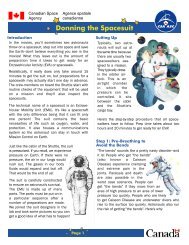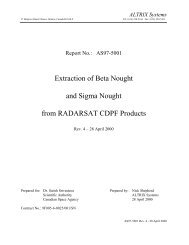PDF version of COSPAR - Space Science Research in Canada Report
PDF version of COSPAR - Space Science Research in Canada Report
PDF version of COSPAR - Space Science Research in Canada Report
You also want an ePaper? Increase the reach of your titles
YUMPU automatically turns print PDFs into web optimized ePapers that Google loves.
The astronauts will loop willow stems and place them, along with unloopedcontrols, <strong>in</strong> a NASA-built <strong>in</strong>cubator called APEX (Advanced Plant EXperimentson Orbit). The stems will be grown for about a month and then returned to Earthfor analysis. APEX is a jo<strong>in</strong>t CSA-NASA project and the <strong>in</strong>cubator will carry asecond experiment by U.S. researchers to detect the effects <strong>of</strong> stressors <strong>in</strong>space on higher plants. It is scheduled for launch <strong>in</strong> April 2009.APEX-CAMBIUM is designed to use the microgravity environment to shed lighton the role that gravity plays <strong>in</strong> fundamental biological process on Earth.B<strong>in</strong>ary Colloidal Alloy Test (BCAT-5)CSA and NASA are collaborat<strong>in</strong>g on a physical science experiment called BCAT-5 that is designed to test the properties <strong>of</strong> materials <strong>in</strong> microgravity, where theyare not <strong>in</strong>fluenced by convection caused by gravity on Earth. The experimentallows scientists to observe physical phenomena that are difficult or impossible toobserve on Earth because <strong>of</strong> the disruptive effects <strong>of</strong> gravity.BCAT has flown four time previously with different materials samples; the BCAT-5 payload, which will be launched to the <strong>Space</strong> Station <strong>in</strong> 2009, will have 10samples, <strong>of</strong> which three will be Canadian. This research will focus is on theamount <strong>of</strong> energy that can be transported by materials <strong>in</strong> different phases. Onepotential application <strong>of</strong> this <strong>in</strong>formation would be to improve the energy efficiency<strong>of</strong> heat pumps.Soret Coefficient <strong>in</strong> Crude Oil (SCCO)This experiment by eng<strong>in</strong>eer<strong>in</strong>g pr<strong>of</strong>essor Zaid Saghir <strong>of</strong> Ryerson University <strong>in</strong>Toronto is aimed at measur<strong>in</strong>g thermal diffusion <strong>in</strong> oil samples <strong>in</strong> microgravity,where they are not affected by convection caused by gravity. His goal is to verifymathematical equations that predict thermal diffusion and could greatly improvecomputer models <strong>of</strong> oil reservoirs.The results are expected to enhance the ability <strong>of</strong> oil companies to determ<strong>in</strong>e thequality and quantity <strong>of</strong> oil <strong>in</strong> hard-to-reach underground reservoirs and predict thelifetime <strong>of</strong> these reservoirs. The experiment should help improve prospect<strong>in</strong>gtechniques and the efficiency <strong>of</strong> oil extraction.Supported by both the CSA and ESA, SCCO was flown twice aboard theRussian Foton recoverable satellite, once <strong>in</strong> 2005 and aga<strong>in</strong> <strong>in</strong> 2007. Thesamples returned <strong>in</strong> 2007 are currently be<strong>in</strong>g analyzed and results are expectedaround the end <strong>of</strong> 2008.26


